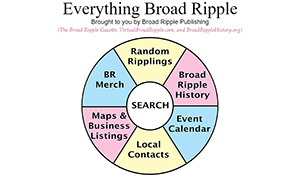
|
Broad Ripple Random Ripplings

The news from Broad Ripple
Brought to you by The Broad Ripple Gazette
(Delivering the news since 2004, every two weeks)

|
| Brought to you by: |

|

|

|

|

|

|
Converted from paper version of the Broad Ripple Gazette (v07n05)
Gettin' Ripped in Ripple - by Laura Minor
posted: Mar. 05, 2010

No Pain, No Gain?
As I have said many times before, the fitness/wellness arena holds many misconceptions, contradictions and myths. Several times a day my trainers and I are asked questions regarding everything from nutrition to shoes and everything else in between. Of course we are happy about this so we can hopefully help to dispel some of the incorrect information out there to the best of our ability.
One such misconception that we often hear is that if a workout does not leave one sore, that it wasn't an effective or challenging session. This is not necessarily true. People tend to equate muscle soreness with workout effectiveness. Let me explain the physiology behind why muscles do get sore after exercise, and then I will clarify why they won't always be sore with a productive workout program.
Muscle soreness (also referred as Delayed Onset Muscle Soreness or DOMS) is actually caused by small tears in your muscle fibers which is how the muscle responds when overloaded. Muscles are distressed when they are made to perform actions they are not used to, such as working out harder than usual, taking up a new sport, or beginning a new workout program. The greater the intensity of exercise that is performed, the greater the muscle soreness experienced afterwards. In the days that follow intense exercise, muscle cells repair and regenerate themselves and they get stronger in preparation for performing the activity again. After this recovery process, the muscles function more efficiently and are more resistant to damage. This process is known as adaptation.
For example, when we have a client for the first time, particularly if they haven't been doing much activity previously, they are typically pretty sore in the few days after the workout. In fact, many of them are a little anxious when they come in for their next appointment, but in the high majority of cases they are also surprised when they do not experience nearly the level of DOMS as they had from their first experience.
Now let me explain why it would actually be a bad thing if your body is sore after every workout. When you have a regular workout routine that is challenging, your body is in the training phase. Therefore, as you train your body should become more efficient to the stresses and intensity routine and as a result, less sore. Being less sore with the same level of intensity is a sign of becoming more strong. . . not less! Rest and recovery are essential for growing stronger and building lean muscle tissue. If you're sore after every workout, you may need more time to recover or you risk overtraining and injury. I remember the phrase "Muscles do not grow in the gym."; very true. If you do not get adequate rest and recovery, you will not get anywhere in your strength program.
So, the question you may have at this point may be "If soreness doesn't work for measuring effectiveness, how do I know if I am getting a good workout?" Here are a few tips:
• Lift Enough Weight: Choose weight that is heavy enough to fatigue your muscle in the desired amount of repetitions. If you finish your set and realize you could have done several more reps, then you should be using more weight if you are looking to increase strength. If you are looking to maintain current strength, simply keep using the weight you are working with (but remember, you probably won't be sore as your body has trained itself for that weight, but that is a good thing).
• Mix It Up: Change up your routine every 4-6 weeks to avoid plateaus. No need to over complicate it though. This could involve just a slight change to your program such as changing your grip position in a bicep curl using different equipment such as balls and bands or new types of abdominal exercises. This will keep you moving ahead and avoid a standstill in your program.
• Work all Muscle Groups: Whether you hit your entire body or split it up into alternating days, try to hit all muscle groups 2-3 times a week with at least one muscle group if not more for each exercise. Just be sure to practice good form and get adequate rest in between sessions.
• Challenge Yourself: Obviously, if a workout leaves you pretty pooped and you were able to mentally and physically push through the difficult points you weren't doing an "easy" workout. You will probably be able to tell if your workout is effective by assessing the difficulty level.
Soreness is your body's way of letting you know that you gave it a bit of a shock which is normal when overloading your muscles, but it isn't what you are looking for each time you physically exert yourself. Literally don't beat yourself up. . . and you will be able to gain the strength gains you desire in a healthy way.
Laura Minor owner and operator of So.Be.Fit. Personal Training and Fitness studio located at 54th and the Monon. She is passionate about teaching others how to "FIT" exercise and physical activity into their daily lives, and have fun while doing so! Visit her website at www.sobefitindy.com or e-mail laura@BroadRippleGazette.com
laura@broadripplegazette.com

|

|

|
| Brought to you by: |

|

|

|
| Brought to you by: |

|

|

|
| Brought to you by: |

|

|

|
| Brought to you by: |


